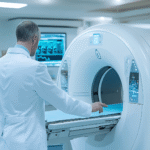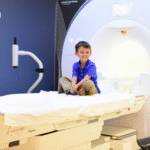Imagine this – you are experiencing persistent abdominal pain, unexplained digestive issues and a few issues with your overall health. Modern medicine has come up with several options in this context, and the CECT scan is one of the excellent tests to address this issue.
A CECT whole abdomen scan is one of the highly advanced diagnostic imaging techniques that offers a complete insight into the abdominal health conditions. The test should be a good imaging technique to use if you’re experiencing unexplained abdominal pain or your doctor needs to monitor existing health conditions.

What is CECT for Abdomen?
CECT test stands for Contrast-Enhanced Computed Tomography. It represents a specialised form of CT scan that utilises iodine-based contrast dye to enhance image clarity. The test uses X-ray beams that rotate around your body while you lie on a motorised table.
A contrast material is injected into the bloodstream through an intravenous line. This helps improve the visibility of blood vessels, soft tissues, and potential abnormalities.
The scan can help the experts evaluate the multiple organs simultaneously – liver, kidneys, pancreas, spleen, intestines, gallbladder, adrenal glands, urinary bladder, lymph nodes, and major abdominal blood vessels.
Purpose of an Abdomen CECT Test
The CECT scan is prescribed for many diagnostic purposes. In fact, it has been considered to be the prime tool in modern medicine.
The primary applications of the CECT scan include
- Tumour Detection and Cancer Staging: The scan detects both benign and malignant tumours in organs such as the liver, pancreas, kidneys, and spleen.
- Internal Infection and Abscess Detection: CECT can locate intra-abdominal infections, abscesses, and inflammatory conditions like appendicitis, diverticulitis, or pancreatitis with high accuracy.
- Trauma Assessment: For emergencies, this imaging technique rapidly detects internal bleeding, solid organ injuries, and traumatic complications
- Gastrointestinal Conditions: The scan effectively identifies intestinal obstructions, bowel perforations, inflammatory bowel diseases, and mesenteric abnormalities.
- Stone Detection: It can locate kidney stones, gallstones, and other calcifications within the abdominal cavity.
- Vascular Abnormalities: CECT visualises major abdominal vessels, detecting aneurysms, thrombosis, or vascular malformations.
- Unexplained Abdominal Pain: CECT provides comprehensive diagnostic information when other tests fail.
Procedure of Abdomen CECT Scan
The CECT scan follows a systematic approach in making sure that the patient is safe and the radiologists get an optimum image –
Step 1: Pre-Scan Preparation
Once you arrive at the centre, you will need to change into the hospital gown. You are advised to remove all metallic objects from your body. The medical staff will review your medical history, current medications, and any known allergies.
Step 2: IV Line Placement
The qualified technician will insert an intravenous catheter into your hand or arm. The contrast dye is administered through the catheter. You may feel a slight pinching sensation during the insertion of the needle.
Step 3: Positioning on the Scanner Table
You are made to lie on a flat motorised table. The table slides into a CT scanner through the circular opening. The technician may use pillows and straps to ensure proper positioning and avoid movement.
Step 4: Contrast Agent Administration
The iodine-based contrast is inserted through the IV line. You may experience a warm sensation, a metallic taste, or a brief flushing feeling.
Step 5: Image Acquisition
The CT scanner rotates around your body. During this process, the machine captures the detailed cross-sectional images. You are expected to stay completely still.
Step 6: Scan Completion
The entire scanning process takes around 15 to 30 minutes. Once completed, the IV line is removed. You can typically resume normal activities immediately.
How to Prepare for a Whole Abdomen CECT Scan?
The CECT whole abdominal scan needs a lot of preparation.
Step 1: Fasting Requirements
You need to fast for over 4 to 6 hours before the scheduled appointment. It also reduces the possibility of nausea. You may be permitted to consume clear liquids 2 hours before the test.
Step 2: Hydration Guidelines
Increase the fluid intake just before the scan. Continue drinking plenty of water after the procedure. This helps flush the contrast agent from your system.
Step 3: Medical History Disclosure
Inform the healthcare team about any allergies. Inform about current medications, particularly diabetes medications, blood thinners, or thyroid medications. Patients with kidney disease, asthma, or thyroid disorders require special precautions.
Step 4: Pre-Scan Blood Work
Complete any required blood tests to assess kidney function before your appointment. This is important in patients with diabetes, kidney disease, or those taking certain medications.
Step 5: Clothing and Personal Items
Wear comfortable, loose-fitting clothing without metal components. Remove all jewellery, dental appliances, hearing aids, and any metallic objects before the scan.
Step 6: Arrival and check-in
Arrive 15-30 minutes early to complete paperwork, insurance verification, and final medical screening. Bring your referral letter, insurance cards, and any previous imaging studies.
Benefits of a Whole Abdomen CECT Scan
The CECT whole abdomen test offers multiple advantages. That should make it a preferred diagnostic tool among healthcare professionals.
- Early Disease Detection: The test helps identify diseases in their early stages. Conditions like tumours, cysts, infections, and inflammatory processes can be detected with high precision.
- Superior Image Quality: CECT provides exceptional contrast resolution and detailed cross-sectional images of abdominal organs. The contrast enhancement allows clear visualisation of blood vessels, soft tissues, and subtle abnormalities.
- Non-Invasive and Quick: The procedure is completely non-invasive. Most scans are completed within 30 minutes.
- Comprehensive Organ Evaluation: CECT provides simultaneous evaluation of multiple abdominal structures.
- Accurate Pre-Operative Planning: Surgeons rely on CECT images for detailed surgical planning
- Treatment Monitoring: The scan effectively monitors disease progression, treatment response, and post-operative complications
- Emergency Diagnostic Capability: In trauma situations, CECT provides rapid, life-saving diagnostic information.
Risks of a Whole Abdomen CECT Scan
The whole abdomen CECT test is safer. However, it does come with its own side effects and risks.
- Radiation Exposure: CT scans involve ionising radiation exposure. However, the radiation dose per scan is relatively low.
- Contrast-Related Reactions: The most common side effects are caused by the iodine-based contrast agent. You may face Nausea, vomiting, metallic taste, warm flush, or temporary discomfort at the injection site.
- Kidney Complications: Contrast-induced nephropathy can occur. This risk is minimised through proper hydration and kidney function assessment before the procedure.
- Medication Interactions: Certain medications, especially metformin for diabetes, may need to be temporarily discontinued before and after contrast administration
Special Population Concerns:
- Pregnancy: Generally contraindicated due to radiation exposure and potential contrast effects on the developing fetus
- Breastfeeding: Safe to continue breastfeeding after contrast administration
- Thyroid conditions: Iodine-based contrast may affect thyroid function in patients with hyperthyroidism
- Claustrophobia: Some patients may experience anxiety or discomfort in the enclosed CT scanner environment.
Post Scan Instructions and Follow Up Care
Once your CECT scan is completed, there are a few post-scan instructions that you need to follow.
- Immediate Post-Scan Monitoring: You’ll be observed for 15-30 minutes after the procedure to monitor for any immediate adverse reactions
- Hydration Protocol: Drink at least 5-8 glasses of water over the next 24 hours to help flush the contrast agent from your system through urination.
- Activity Restrictions: You can typically resume normal daily activities immediately after the scan unless you received sedation.
- Dietary Guidelines: No special dietary restrictions apply after the scan. You may eat and drink normally unless otherwise instructed by your healthcare provider.
- Injection Site Care: Monitor the IV insertion site for signs of infection. Apply a warm, moist compress 4 times daily for 15-20 minutes if mild irritation occurs.
When to Contact Your Doctor
Seek immediate medical attention if you experience:
- Persistent nausea or vomiting lasting more than 24 hours
- Signs of allergic reaction, such as hives, difficulty breathing, or throat swelling
- Injection site complications that worsen or persist beyond 48 hours
- Any concerning symptoms that develop after leaving the facility
Results Timeline
Your scan results are typically reviewed by a specialised radiologist and reported to your referring physician within 24-48 hours.
Conclusion
The CECT whole abdomen scan is a comprehensive test that helps you with a complete diagnostic. This scan has been popular in Kerala in general and Thrissur in particular. The advanced imaging technique combines cutting-edge technology with contrast enhancement to provide detailed visualisation of abdominal organs.
Be it in Thrisur or throughout Kerala, Magnus Diagnostics is regarded as one of the premier diagnostic facilities for advanced imaging services, including CECT scans. Their services are accompanied by state of the art facilities and cutting edge technology. That makes Magnus Diagnostics a preferred destination for both patients and clinicians.
For anyone seeking reliable, up-to-date diagnostic services in Thrissur or Kerala, Magnus Diagnostics is widely recognised as a leading choice for CECT and other advanced scans, thanks to its expert staff, modern technology, and strong reputation for patient care.
FAQ
1. Why is a CT Whole Abdomen scan done?
The CECT whole abdomen scan is suggested in various conditions of internal abdominal organs. It is helpful in diagnosing tumours (both benign and malignant), infections, abscesses, internal injuries, bowel obstructions, kidney stones, and gallstones.
2. Who Should Avoid a Whole Abdomen CECT Scan?
Pregnant women should avoid the test due to radiation exposure risks. Patients with severe kidney disease may also face a few issues with the contrast dye. If you are allergic to iodine, you should avoid the scan.
3. Can I eat or drink before the Abdomen CT scan?
You should fast for 4 to 6 hours before the CECT examination. You can have clear liquids two hours before the test. However, patients with diabetes may have food 3 hours before the test.
4. What Are the Alternatives to Abdomen CECT Scan?
MRI can be a good option as an alternative to a CECT scan. Ultrasound provides real-time imaging without radiation. It is useful for scan gallbladder, kidney stones, and fluid collections. Plain CT scans without contrast can detect some conditions, like kidney stones and certain organ abnormalities.

